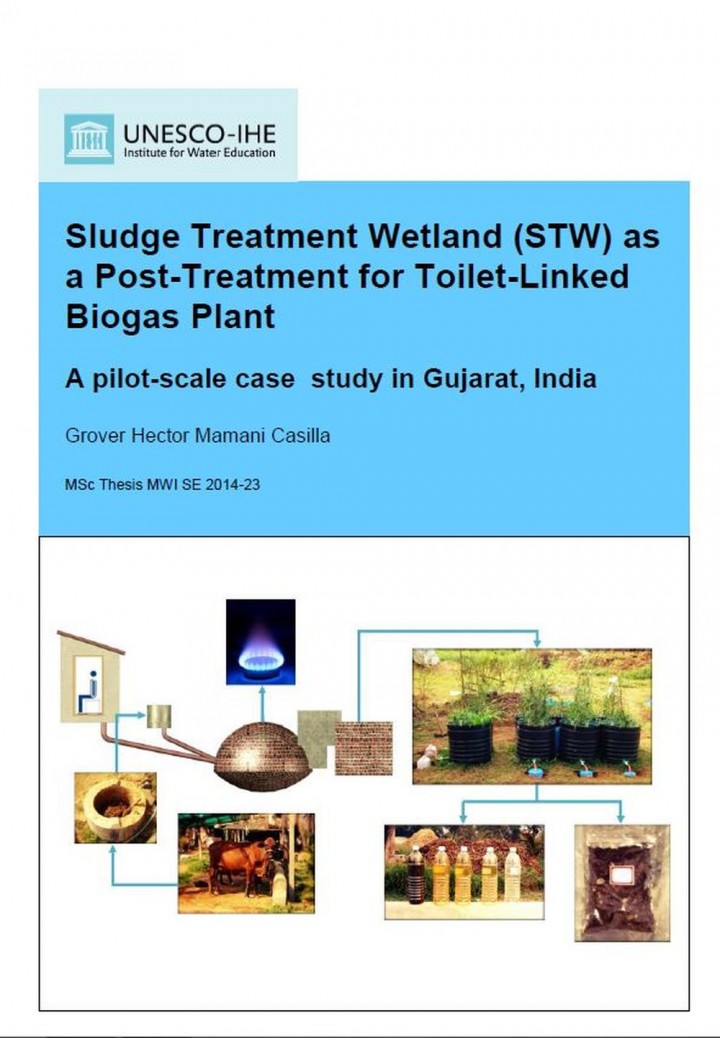Sludge Treatment Wetland (STW) as a Post-Treatment for Toilet-Linked Biogas Plant A pilot-scale case study in Gujarat, India Mamani Casilla, G. H. (2014)
Since 1900's, anaerobic biogas digester had been applied successfully in Asian countries like India, Nepal and China, treating cow manure, pig excreta, organic waste or a combination of them, providing not only biogas, which is used as source of energy, but also slurry used as soil conditioner.
During last 20 years in India, different government and private institutions promoted the use of toilet linked biogas plants (TLBPs) especially in rural area. TLBP is a modification of the household-size anaerobic biogas digester which includes toilet effluent connection through a pipeline. This system not only generates biogas and slurry, but also offers a new option for wastewater disposal and treatment. However, little is known about the slurry's properties, and previous research studies recommended a post-treatment of TLBPs effluent, prior its use as soil amendment. One of the options are sludge treatment wetlands (STWs).
This research characterized the TLBPs effluent by determining its physico-chemical properties and microbiological quality; and also, evaluated the performance of four pilot-scale STWs operated at different sludge loading rates (40.5, 81.0, 121.5 and 162.0 kgTSS/m2-year). After sludge treatment two main products are generated: the biosolid accumulated at the STWs top layer and the water leachate collected at the bottom layer. Both products were evaluated from a reuse in agriculture point of view. Additionally the potential biomass production was compared for two plant species, Phragmites karka and Napier Bajra hybrid grass.
The four sludge treatment wetland configurations showed similar efficiencies in terms of nutrients concentration, mineralization and hygienisation, but regarding to sludge dryness, significant differences were observed at different loading rates. In fact, a loading rate of 108 kgTSS/m2-year is recommended to obtain a product with appropriate moisture content. On the other hand, the water leachate collected at the bottom of STWs has a quality enough to comply with the standard limits for reuse in agriculture; it can be reused for irrigation.
The TLBP is a very good on-site sanitation example, applicable especially in rural area of India. If a STW is implemented as slurry's post-treatment, not only the slurry's quality is improved, but also treated water if produced, has a potential reuse for irrigation. Additionally, the plants used in STW (Phragmites karka and Napier Bajra hybrid grass) could be a good source of foliage for cows and buffalos; however more specific tests have to be conducted in order to evaluate the plants' pollutant accumulation.
Bibliographic information
Mamani Casilla, G. H. (2014). Sludge Treatment Wetland (STW) as a Post-Treatment for Toilet-Linked Biogas Plant A pilot-scale case study in Gujarat, India MSc thesis, UNESCO-IHE Institute for Water Education, Delft, the Netherlands
Filter / Tags
Biogas systems Constructed wetlandsFaecal sludge treatment processesCase studies in other formatsEnglish
Downloads
Sludge Treatment Wetland (STW) as a Post-Treatment for Toilet-Linked Biogas Plant
Type: application/pdf
Size: 3.25 MB

